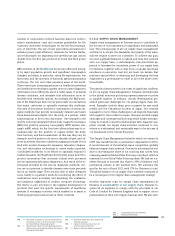Siemens 2011 Annual Report Download - page 163
Download and view the complete annual report
Please find page 163 of the 2011 Siemens annual report below. You can navigate through the pages in the report by either clicking on the pages listed below, or by using the keyword search tool below to find specific information within the annual report.
153 D. Consolidated Financial Statements
273 E. Additional information
143 C.2 Additional information for supplemental
financial measures
145 C. Siemens AG (Discussion on basis of
German Commercial Code)
151 C. Notes and forward-looking statements
140 C. Information required pursuant to Section ()
and Section () no. of the German Commer-
cial Code (HGB) and explanatory report
142 C. Compensation report and Corporate Governance
statement pursuant to Section a of the German
Commercial Code (HGB)
number of components of which has been halved in order to
reduce maintenance costs and increase profitability for the
customer; innovative technologies for the low-loss transmis-
sion of electricity; the use of new gas turbine generations to
enhance power plant efficiency; materials for turbine blades;
and technologies for separating the greenhouse gas carbon
dioxide from the flue gas produced by fossil fuel-fired power
plants.
R&D activities in the Healthcare Sector are influenced strong-
ly by rapid population growth and significant demographic
changes, including, in particular, rising life expectancies, low
birth rates, and the inversion of historical age-group pyramids
in Europe, the U.S. and other populous areas of the world.
These trends put increasing pressure on healthcare providers
and healthcare technology to gather more accurate diagnostic
information more efficiently, about a wider range of potential
disease conditions, and integrate that information more ef-
fectively with treatment options. Accordingly, the R&D activi-
ties of the Healthcare Sector focus particularly on innovations
that assist customers in optimally meeting this challenge.
One area of innovation involves a combination of various im-
aging methods that provide increasingly detailed and faster
three-dimensional insights into the body of a patient, while
subjecting him or her to less discomfort. One example is the
world‘s only fully integrated whole-body magnetic resonance
(MR) and positron emission tomography (PET) system, Bio-
graph mMR, which for the first time allows physicians to si-
multaneously see the position of organs within the body,
their function, and their metabolism. In this way they can, for
example, see the position of a tumor, identify its type, and ob-
serve its activity. Siemens combines imaging processes of this
kind with modern therapeutic measures, laboratory diagnos-
tics, and information technology to create vastly improved,
coordinated workflows. In its efforts to optimally respond to
market demands, the Healthcare Sector gives equal priority to
product innovations that automate clinical work processes
and on optimizing laboratory diagnostics. As a result of the in-
formation provided by the various diagnostic methods, doc-
tors are in a position to identify diseases even more precisely
and at an earlier stage. They are also able to tailor therapies
more closely to a patient’s needs by monitoring the effect of
medications more accurately and exploiting the evaluation
and analytical capabilities of modern computer technology.
The Sector is also involved in the targeted development of
products that meet the specific requirements of healthcare
systems of emerging countries, which enables us to assist in
developing primary medical care in these countries.
C... SUPPLY CHAIN MANAGEMENT
Supply chain management at Siemens aims to contribute to
the success of our businesses in a significant and sustainable
way. The principal goal of all our supply chain management
activities is to ensure the availability and quality of the mate-
rials we require to serve our customers. To achieve this goal,
we need a globally balanced, localized and close-knit network
with our supply base, a well-designed cross-functional ap-
proach to leverage the innovation power of our supply base
for Siemens, together with a clear focus on global functional
excellence in execution. Last but not least, we believe that
putting a special effort in attracting and developing the best
employees is a prerequisite to excel in all of the above men-
tioned fields.
The past fiscal year proved to be a year of significant challeng-
es for our supply chain management. Dynamic developments
in the global economy put strong upward pressure on prices
in supplier markets. In addition, certain developments pre-
sented particular challenges for our global supply chain net-
work. Examples include sharp price increases for rare earth
metals and the Fukushima incident in Japan. Our network
managed to rise to these challenges in all respects. Especially
with regard to the incident in Japan, Siemens avoided supply
shortages and consequential line stops while further strength-
ening
its trusted, long-term relationships with Japanese sup-
pliers. Overall, our supply chain activities continued to con-
tribute in a substantial and sustainable way to the success of
our businesses in the current fiscal year.
The Supply Chain Management Initiative which we started in
was transferred into a permanent organization in .
A central element of the initiative was a competitive, globally
balanced supply chain network. One key to achieving this bal-
ance is increasing the share of our sourcing that comes from
emerging markets (Global Value Sourcing countries), which is
measured in our Global Value Sourcing share. We had set our-
selves the goal to increase this share to % of Siemens’ total
purchasing volume in the medium term. We achieved this
goal by the end of fiscal , with % for Siemens in total.
The global balance of our supply chain network continues to
be a central part of our supply chain management strategy.
Another important topic for supply chain management at
Siemens is sustainability in our supply chain. Siemens re-
quires all its suppliers to comply with the principles of our
Code of Conduct for Siemens Suppliers and to support its im-
plementation in their own supply chains as well. We also initi-
























